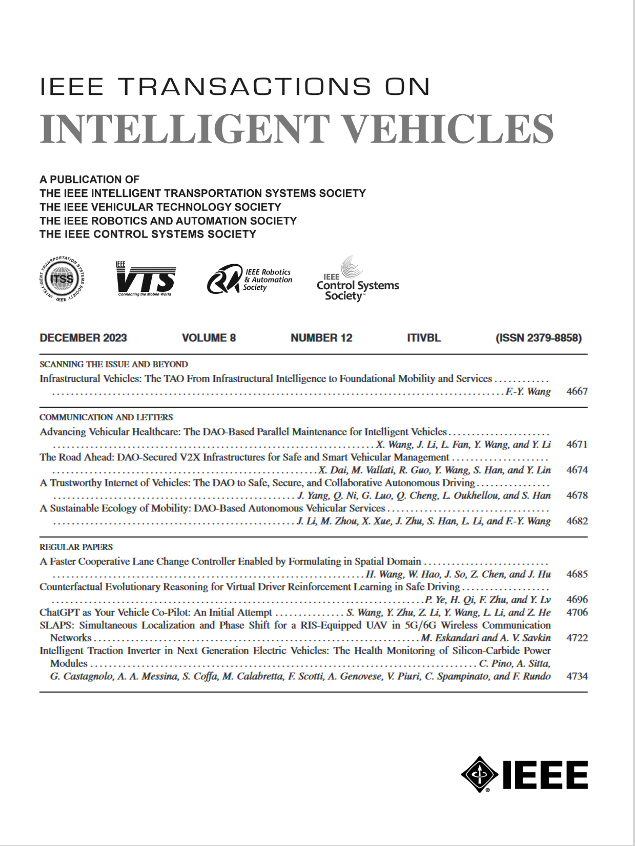基于自适应深度图神经网络的复杂环境下无人机- ugv动态任务分配
IF 14.3
1区 工程技术
Q1 COMPUTER SCIENCE, ARTIFICIAL INTELLIGENCE
引用次数: 0
摘要
采用自适应深度图神经网络(AD-GNN)与仿生算法相结合的方法,研究了复杂城市环境中无人机(uav)和无人地面车辆(ugv)的动态任务分配(DTA)问题。目标是提高参与侦察、战斗、中继、自杀和电子战任务的无人机和ugv的协同作战效率。所提出的方法通过城市搜索和救援、反恐和灾害管理等场景进行验证。AD-GNN算法根据场景复杂度动态调整深度,仿生算法通过模拟自然过程优化任务分配。现有方法往往侧重于静态任务分配或单独增强无人机和UGV的能力,在不可预测的城市环境中缺乏适应性和效率。AD-GNN模型通过实时调整其复杂性,优化任务分配决策来解决这些限制。仿生算法的集成增强了鲁棒性和灵活性,以适应不断变化的操作需求。在广泛的城市环境中使用真实世界地理信息系统(GIS)数据的模拟显示了任务分配效率的显着提高。优化后,无人机和ugv在搜索和救援行动中实现了85%以上的操作效率,在灾害管理场景中实现了90-95%的操作效率。这些结果突出了该模型在动态和不可预测的城市环境中有效管理和分配任务的能力。总之,本文通过为城市环境中的DTA提供创新解决方案,为自主系统做出了贡献,展示了将先进的图神经网络与仿生原理相结合的潜力,以增强无人机和UGV车队在复杂环境中的操作。本文章由计算机程序翻译,如有差异,请以英文原文为准。
Adaptive Depth Graph Neural Network-Based Dynamic Task Allocation for UAV-UGVs Under Complex Environments
This paper investigates dynamic task allocation (DTA) for unmanned aerial vehicles (UAVs) and unmanned ground vehicles (UGVs) in complex urban environments using an adaptive depth graph neural network (AD-GNN) combined with biomimetic algorithms. The goal is to improve collaborative operational efficiency for UAVs and UGVs engaged in reconnaissance, combat, relay, suicide, and electronic warfare tasks. The proposed approach validates through scenarios like urban search and rescue, counterterrorism, and disaster management. AD-GNN dynamically adjusts its depth based on scenario complexity, while biomimetic algorithms optimize task allocation by emulating natural processes. Existing methods often focus on static task allocation or separate enhancement of UAV and UGV capabilities, lacking adaptability and efficiency in unpredictable urban settings. The AD-GNN model addresses these limitations by adjusting its complexity in real-time, optimizing decision-making for task allocation. The integration of biomimetic algorithms enhances robustness and flexibility, adapting to changing operational demands. Simulations using real-world geographic information system (GIS) data in extensive urban settings demonstrate significant improvements in task allocation efficiency. UAVs and UGVs achieve operational efficiencies above 85% in search and rescue operations and 90–95% in disaster management scenarios after optimization. These results highlight the model's capability to manage and allocate tasks efficiently in dynamic and unpredictable urban environments. In conclusion, this paper contributes to autonomous systems by offering an innovative solution for DTA in urban settings, showcasing the potential of integrating advanced graph neural networks with biomimetic principles to enhance UAV and UGV fleet operations in complex environments.
求助全文
通过发布文献求助,成功后即可免费获取论文全文。
去求助
来源期刊

IEEE Transactions on Intelligent Vehicles
Mathematics-Control and Optimization
CiteScore
12.10
自引率
13.40%
发文量
177
期刊介绍:
The IEEE Transactions on Intelligent Vehicles (T-IV) is a premier platform for publishing peer-reviewed articles that present innovative research concepts, application results, significant theoretical findings, and application case studies in the field of intelligent vehicles. With a particular emphasis on automated vehicles within roadway environments, T-IV aims to raise awareness of pressing research and application challenges.
Our focus is on providing critical information to the intelligent vehicle community, serving as a dissemination vehicle for IEEE ITS Society members and others interested in learning about the state-of-the-art developments and progress in research and applications related to intelligent vehicles. Join us in advancing knowledge and innovation in this dynamic field.
 求助内容:
求助内容: 应助结果提醒方式:
应助结果提醒方式:


